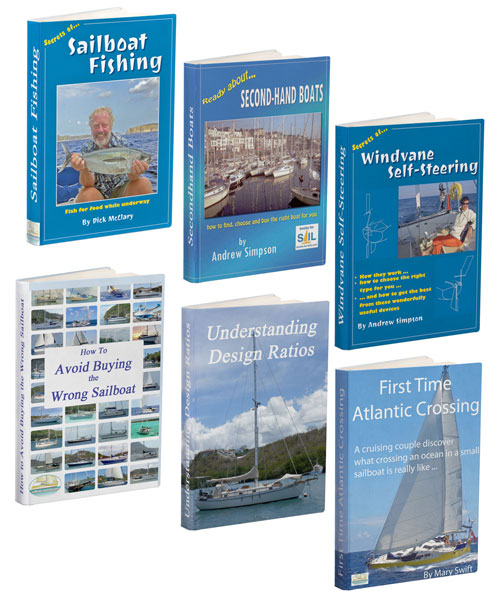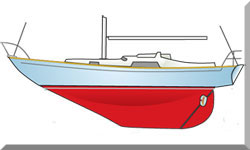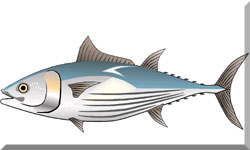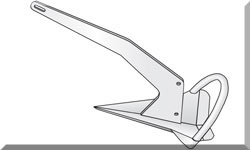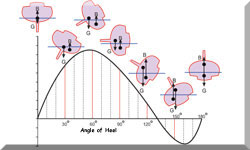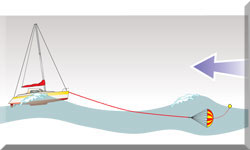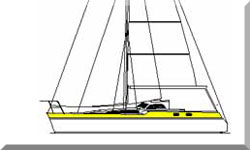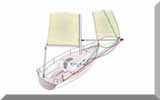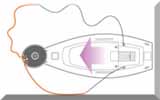Taming the Tempest: Your Guide to the Jordan Series Drogue
As sailors, we're always chasing fair winds and calm seas.
But the ocean, in its magnificent indifference, doesn't always play along. Every serious cruiser eventually faces genuinely nasty weather, when waves aren't just playful bumps but real monsters set on damaging your boat—and you. In those moments, knowing you have a reliable heavy-weather strategy can be a game-changer. For many, that strategy involves the Jordan Series Drogue.
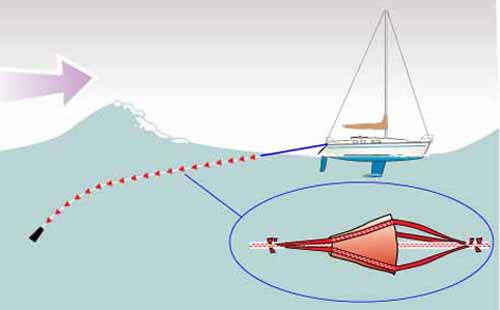 The Jordan Series Drogue
The Jordan Series DrogueYou've probably heard of sea anchors and drogues. Both slow a boat in a storm, but they work differently and for different purposes. A sea anchor usually deploys from the bow, aiming to bring the boat to a near standstill, nose into the waves. A drogue, on the other hand, streams from the stern, allowing the boat to run with the waves, but at a greatly reduced, controlled speed. The Jordan Series Drogue, or JSD, is a specific type of drogue, and it has earned an almost legendary reputation for handling the absolute worst the ocean can dish out.
Why the Jordan Series Drogue Stands Out
The Jordan Series Drogue isn't just one big cone or parachute. Picture a very long line, perhaps 100 to 200 metres (around 330 to 660 feet) in length, dotted with 100 to 200 small, five-inch diameter cones at regular intervals. At the very end of this line, a weight, usually a chain of about 15 to 25 pounds (7 to 11 kg), keeps the drogue submerged. This multi-cone design is the genius behind the JSD, conceived by aeronautical engineer Don Jordan in collaboration with U.S. Coast Guard researchers after the disastrous 1979 Fastnet Race.
Why so many small cones instead of one big one? Older drogues often filled with water and then collapsed under storm wave strain, causing jerky loads and potential fatigue failure. The series drogue, with its multitude of cones, ensures there’s always a drag force on the line. Think of it like a hundred little hands constantly gripping the water, spreading the load and preventing those sharp, snatching forces that can wreak havoc on your boat and its gear. This consistent drag also keeps the line from going slack, which is a major factor in reducing shock loads on deck fittings.
The JSD deploys from the stern of the boat, typically attached via a strong V-bridle to reinforced attachment points on the transom. The goal is to keep the stern pointed directly into the oncoming waves. While some sailors might worry about being "pooped" (a wave breaking over the stern), studies and real-world experience demonstrate that a properly deployed Jordan Series Drogue actually causes the stern to rise quickly to steep seas, ensuring safe vessel performance.
When You'll Be Glad You Have One: Beyond Rough Seas
Most of us will encounter "heavy weather"—strong winds and big seas—at some point. But there's a huge difference between a lively gale and a truly dangerous breaking wave. Breaking waves, especially those formed by interacting storm waves, carry immense destructive power. They can literally pick up a boat and toss it, leading to capsize, dismasting, or structural damage. This is where the Jordan Series Drogue truly shines. Its main job is to prevent sailboat capsize prevention and total loss of a vessel when hit by such a breaking wave. It allows the boat to accelerate with the breaking wave for a short period, then gently decelerates it as the drogue fully engages, effectively pulling the boat through the breaking crest.
Beyond survival, the JSD also significantly improves the boat's motion in storm waves. It makes the ride much more comfortable and cuts down on drift. Imagine trying to actively steer your boat for hours, even days, in hurricane-force winds and enormous seas. It's exhausting, and often dangerous to be on deck. The Jordan Series Drogue is designed as a "set it and forget it" system—once deployed, it needs no active steering, allowing the crew to go below, rest, and focus on other aspects of storm management. This is a crucial element of effective sailboat storm tactics.
Getting It Right: Crucial Jordan Series Drogue Installation Tips
While the Jordan Series Drogue itself is an engineering marvel, its effectiveness relies entirely on correct installation. This isn't a piece of gear you can just tie off to any old cleat and hope for the best. The forces exerted by the drogue in extreme conditions can be enormous—we're talking thousands of pounds of pull. So, the attachment points on your boat are paramount.
The Jordan Series Drogue connects to your boat via a bridle, which usually attaches to two strong points on the transom. These points need substantial reinforcement. For many fiberglass boats, this means beefing up the deck and cleats, or even fabricating external plates with internal backing plates. Some sailors opt for robust chainplates or heavy-duty padeyes that are through-bolted and reinforced with layers of carbon biaxial weave or similar strong materials on the inside of the hull. The rule of thumb here is simple: if you can’t hang your boat from those attachment points, they’re not strong enough for a JSD.
Chafe is another critical consideration. The drogue line and bridle will be under immense tension, constantly moving against any surfaces they touch. You must eliminate all possible chafe points, especially where the bridle exits fairleads or hawse holes, or thoroughly protect them with heavy-duty chafe gear. Shackles should be moused, and eye splices should incorporate stainless steel thimbles to prevent wear.
The drogue's size—the number of cones and the line's diameter—is carefully calculated based on your boat's displacement. It’s not a one-size-fits-all solution; you absolutely need a series drogue properly engineered for your specific vessel. Generally, it's recommended to err on the side of caution and slightly "over-engineer" for hurricane-force conditions.
Deployment & Retrieval: Practice Makes Perfect
One of the Jordan Series Drogue's design goals was that it should be deployable with one hand in storm conditions without leaving the cockpit, and without fouling. This is largely achieved through careful preparation and storage. Many experienced sailors suggest storing the drogue flaked into a launch bag, with the bridle ready to be shackled on and secured. When the time comes, the chain weight drops overboard, and the drogue feeds out. The deceleration is gradual, not abrupt.
Retrieval, however, can be a bit of a chore. Imagine pulling in hundreds of metres of line with dozens of water-filled cones attached. It’s definitely not a quick hand-over-hand job. Many sailors use a retrieval line attached to the bridle, then use their largest cockpit winches, taking the line in bit by bit, letting the motion of the sea assist. The good news is that the cones tend to collapse once out of the water, making them easier to winch in. Practice is key—deploying and retrieving the Jordan Series Drogue in calm conditions, with all crew members involved, will ensure everyone knows the drill when it truly matters. This contributes to overall offshore safety gear preparedness.
Real-World Perspectives & What to Consider
The Jordan Series Drogue has a solid track record. Sailors who have used it in extreme conditions often rave about its effectiveness in taming otherwise terrifying seas, allowing them to ride out storms with a level of control and safety they wouldn't otherwise have. One cruiser, returning from the Azores in a gale with winds over 50 knots, deployed his JSD when boat speed hit 13.86 knots and called it "excellent," holding the boat stern-to-wind and making about 2 knots.
However, it’s also vital to be realistic. No single piece of equipment is a magic bullet for all storm conditions. The Jordan Series Drogue is a serious piece of kit for serious situations. It’s generally considered for well-found, blue-water cruising boats, not lighter trailer boats. While the JSD is a "set and forget" system once deployed, the deployment itself, and certainly the retrieval, demand careful planning and execution.
Cost is another factor. A new Jordan Series Drogue can be a significant investment, often running over $1,000 USD, and that's not including the cost of installation or reinforcement for attachment points. Still, for a blue water cruising safety strategy, it’s often seen as essential safety equipment, like a liferaft or EPIRB—something you hope you never need, but are incredibly grateful to have if you do.
The Bottom Line: Is a Jordan Series Drogue Right for You?
The Jordan Series Drogue is a highly effective, well-researched, and proven heavy-weather device. Its multi-cone design offers clear advantages in consistent drag and reduced shock loads compared to other drogue types. For recreational sailors embarking on offshore or blue-water passages, having a Jordan Series Drogue aboard, properly installed, and with a crew trained in its deployment and retrieval, provides a significant boost in safety and peace of mind when facing the unbridled fury of the ocean. It isn’t a substitute for good seamanship or sound boat maintenance, but it’s a powerful tool in your storm survival toolkit, allowing your boat to gracefully, and safely, dance with the waves rather than fight them head-on.
The Jordan Drogue is one of the final steps in a heavy weather strategy, which begins with getting to grips with how to correctly and safely reef your sails, a topic we explore in our comprehensive guide, Reefing a Sail: The Ultimate Guide to Control & Safety at Sea.
Recent Articles
-
Sailboat Wheel Steering Maintenance & Inspection Checklist
Dec 30, 25 02:32 PM
Keep your vessel’s helm responsive and reliable with our expert maintenance checklist. Master cable tensioning and system inspections to avoid mid-passage failures. -
Modern Boat Electronics and the Latest Marine Instruments
Dec 20, 25 05:27 PM
Should sailboat instruments be linked to the latest boat electronics as a fully integrated system, or is it best to leave them as independent units? -
Hans Christian 43: Classic Bluewater Cruiser & Liveaboard Sailboat
Dec 10, 25 04:37 AM
Explore the Hans Christian 43: a legendary heavy-displacement, long-keel sailboat. Read our in-depth review of its specs, design ratios, and suitability for offshore cruising and living aboard.
